Homemade Almond Croissants
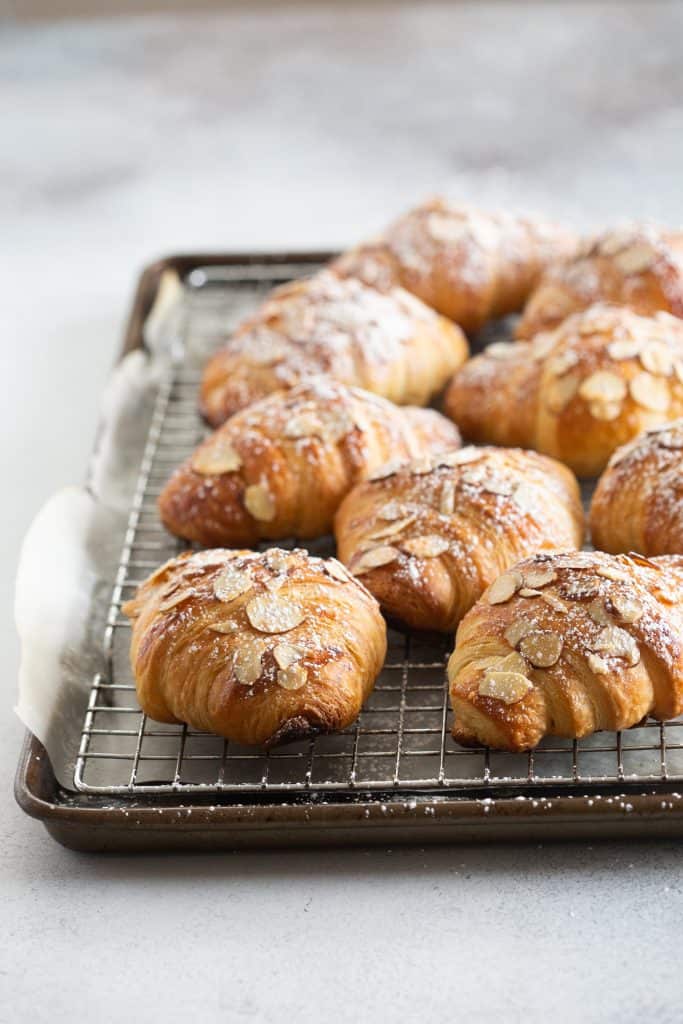
Flaky almond croissants are one of my favorite decadent treats to get from a local bakery or coffee shop. Yes they are a more advanced recipe that takes a day or two to fully come together, but the end result is so delicious and impressive I urge you to give them a try!
A classic croissant is filled with a frangipane filling (also known as almond paste,) and they are topped with crispy and sweet slivered almonds. You’ll be so happy you made these when you sit down with one and your cup of coffee! These are the best almond croissants I have tried because truly nothing compares to made from scratch!
Ingredients needed for Almond Croissant Recipe:
- All purpose flour
- Butter
- Yeast
- Sugar
- Almond Paste
- Sliced Almonds
- Powdered Sugar
- Almond extract (optional)
Supplies needed:
- Large bowl
- Ruler (Or a baking mat with a grid)
- Parchment paper
- Rolling pin
- Pizza Cutter or something similar
- Pastry brush
For homemade croissants, you can fill the dough before rolling, fill them fresh from the oven. Cut the croissants in half horizontally, and spread a layer of the almond cream filling on the bottom half of each croissant. Place the top half of the croissant back on and then sprinkle sliced almonds on top of the croissant, and place them on a prepared baking sheet lined with parchment paper. Bake them in the oven until they’re crispy and golden brown. Once they’re done, let them cool on a wire rack for a few minutes before serving.
Otherwise spread some almond filling into each dough triangle and roll up before proofing.
If you have any leftovers, store them in an airtight container for up to a day. When you’re ready to enjoy them again, place them in a warm place for a few minutes to crisp them up.
Want an almond croissant without the full laminating process? If making your own homemade croissants feels too ambitious, one other option is to simply jazz up some store-bought croissants. You want to start with stale croissants. Either use day-old croissants or toast them in the oven until they’re crispy.
If you feel brave and want to try something new- give this recipe a try!
Here is the timeline I like best for making them and having them ready late morning. My timing is generous as sometimes you need to pop your dough into the freezer if it feels too soft.
Day 1: Start poolish in the evening sometime before bed- cover loosely and let it hang. (I did this around 7 pm.)
Day 2: 8:00 AM make butter block, wrap it in parchment- and put in the fridge
8:30 AM or once the poolish is ready, make your dough and let it proof for an hour.
10:AM or so- Shape dough into a rectangle- pop in freezer for 20 mins- put butter block into freezer for 20 mins as well.
10:30 AM- Encase butter block and do first turn- pop dough into freezer for 20 mins
11:30: Repeat: 2nd turn and then back into freezer for 20 mins
12:30: Repeat: 3rd turn and then back into the freezer for 20 mins
1:30: Roll out the dough to full size, divide in half. Wrap well in plastic wrap and freeze for 20 mins OR chill in fridge overnight. You can also freeze one half of the dough to make more croissants another day. This is usually what I do, and if I start the dough the next morning they are ready to eat around 11 am.
2:30: If you want to continue shaping the croissants, use one half of dough at a time, roll out, cut, and shape croissants. If you are filling them you’ll do this now as well. Repeat with second batch of dough.
3:00- Two choices: Allow croissants to proof at room temp loosely covered for 2 hours. (Will be ready to eat around 5 pm.) OR cover each tray and pop in the fridge until Day 3 so you can proof them and bake in the morning.
Please don’t hesitate to ask me any questions here or on Instagram. I have nothing but time this week and really want to help you!
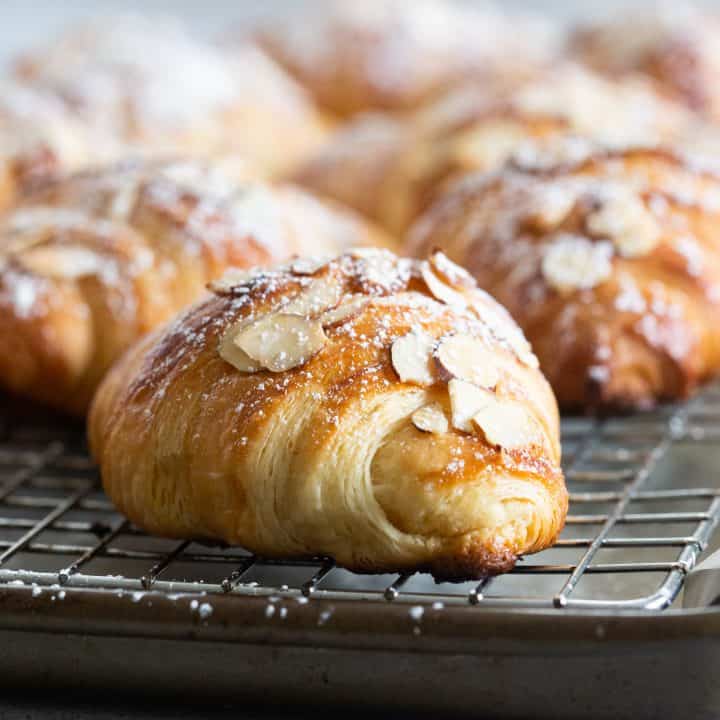
Homemade Almond Croissants
Ingredients
For the Poolish
- 100 g/ 1/2 cup + 3T + 1t All purpose flour
- Pinch of Instant Yeast
- 100 g/ 1/4 cup +2T +2 1/2 t warm water
For the Butter Block:
- 330 g (11.6 oz) European butter (I used Kerrygold)
For the Dough:
- 500 g/ 3 1/2 cups +1T +1/4t All-purpose flour
- 75 g / 1/4 cup +2T +1/4 t sugar
- 3 g/1 t diastatic malt powder
- 10 g/ 1T Yeast (I have used both instant or active dry- both work fine for me)
- 200 g/ 3/4 cup +1T+1 3/4t warm water
- 100 g/ 3.5 oz unsalted butter softened
- 15 g/ 1 T + 2t Salt
- Egg for washing
For Almond Filling:
- 6 oz almond paste
- 57 g/4T butter at room temp
- 30g/1/4 cup powdered sugar
- 2 T egg white
For the Almond Syrup:
- 75g/1/4 cup +2T sugar
- 1/4 cup + 1T water
- 15 g/2T Almond flour/meal
Instructions
- Combine flour and yeast in a medium bowl. Pour in water and mix. Cover bowl loosely with plastic wrap and let sit at room temperature for 12-15 hours.
- Cut the butter into cubes and place in the bowl of a stand mixer fitted with a paddle attachment. Mix on high until smooth and solid with no lumps.
- On a piece of parchment, trace a 6 3/4 x 7 1/2 rectangle. Flip it over and dollop the butter into the middle. Use a spatula to smooth it into the lines the best you can. Fold the parchment over the lines to create a even and flat butter rectangle. Tape it closed and pop in the fridge overnight.
- Combine the flour, sugar, yeast, and malt powder* in the bowl of a stand mixer fitted with a dough hook and give it a quick mix on the lowest setting.
- Pour all but 3 tablespoons of the water into the poolish to loosen it and then pour it into the flour mixture. Add the butter and mix on low for 2 minutes to moisten the dry ingredients. Scrape down the sides and bottom of the bowl to make sure all the flour has been incorporated.
- Sprinkle the salt over the top and mix on low for 2 minutes to dissolve the salt. If the mixture feels at all dry, add the reserved water in very small amounts as needed. Continue to mix on low speed for 20 minutes.
- Run a bowl scraper around the sides and bottom of the bowl to release the dough and turn it out onto a work surface. Stretch the left side of the dough outward and fold it over the center, then stretch and fold the right side over to the opposite side, as if you were folding a letter. Repeat the process, working from the bottom and then the top. Turn the dough over, and place it seam side down in a lightly oiled bowl. Cover the bowl with plastic wrap or a dish towel and let sit at room temperature for 1 hour.
- Line a quarter sheet pan with parchment paper. Uncover the dough, run the bowl scraper around the sides and bottom of the bowl to release the dough, and turn it out onto a lightly floured work surface, disturbing the structure as little as possible. Gently but firmly pat the dough into a rectangle about 10 x 7 ½ inches, pressing any large gas bubbles to the edges and then out of the dough. Transfer to the sheet pan, cover with plastic wrap, and freeze for 20 minutes.
- To encase the butter and roll the dough: Lightly flour the work surface and a heavy rolling pin. Turn the dough out onto the work surface and lightly dust the top with flour. Roll the dough outward from the center, rotating it frequently and flipping and fluffing it from time to time, adding just enough flour to the work surface, dough, and/or pin to prevent sticking, until you have a 16 x 7 ½ x ½ inch thick rectangle.
- Lay the block of butter across the center of the dough. Stretch and fold over the two longer sides so they meet in the center and pinch together to seal. There should be no exposed butter at the top of the block, but you will see the butter on the sides.
- Using the rolling pin, press down firmly on the dough across the seam from one side to the other to expand the dough. Turn the dough so a short end faces you. Roll to expand the length of the dough, flipping, fluffing, and turning the dough over and adding flour only as needed, until you have a rectangle about 22 x 9 inches and 3/8 inch thick.
- Fold the bottom third of the dough up as if you were folding a letter. Fold the top third down to cover the bottom third. Turn the block 90 degrees so the dough resembles a book, with the opening on the right. You will continue this pattern with each roll, and keeping the opening on the right will help you remember how to position the dough. You have completed your first turn; gently press a finger into a corner to mark it. Return to the sheet pan, cover with plastic wrap, and freeze for 20 minutes or until the dough has stiffened but is not hard.
- Lightly dust the work surface with flour. Place the dough on the work surface with the opening on the right. It is important to work with the dough as quickly as possible, but not at the risk of exposing the butter. Pressing on the dough will warm the butter; if it is too cold, it will shatter rather than spread as you roll it. Expand the dough by pressing down firmly with the rolling pin, working up the length of the dough. If the dough cracks at all along the edges, stop and let it warm slightly at room temperature. Then roll out the dough as you did before to a 22 x 9 x 3/8 inch thick rectangle and repeat the folding. Turn the block 90 degrees, so the opening is on the right. Gently press 2 fingers into a corner to mark the dough. Return to the sheet pan, cover with plastic wrap, and freeze for 20 minutes or until the dough has stiffened but is not hard.
- Repeat all of the steps for turn 2 and mark the dough with 3 fingerprints.
- Line a sheet pan with parchment paper and lightly dust the work surface with flour. Place the dough on the work surface with the opening on the right.
- It is especially critical at this stage that the dough remain cold; freeze as needed. Lightly dust the top of the dough and roll it outward from the center, flipping, fluffing, and rotating the dough and turning it over, adding only enough flour to the work surface, dough, and/or pin as necessary to prevent sticking. Roll the dough out to 24 x 9 inches.
- Cut the dough into 2 12x9 pieces and lay on the sheet pan with a piece of parchment in between each. Wrap with plastic wrap and either freeze until ready to use, or for 20 minutes if you're planning to shape the croissants right away
- Spray two sheet pans with nonstick spray and line with parchment paper (or just use 1 sheet pan if only using half the batch of dough).
- Lightly flour the work surface. Remove one piece of dough from the freezer and position it on the work surface with the short end towards you; transfer the second piece of dough (if using at this time) to the refrigerator. Roll the dough out to a rectangle 19 x 9 inches.
- Turn the dough so that a long side is facing you and trim it to 18 inches long. Trim the remaining sides only as needed for straight edges.
- Cut the dough in half, crosswise, so that you have two squares, about 9 x 9 inches wide. Then cut each squash in half so that you end up with four rectangles. Cut each rectangle diagonally so that you end up with 8 right triangles.
- Hold one triangle up by the base with one hand and, using your fingertips, gently pull the dough until it is stretched to about 12 inches.
- Put the dough on the work surface, with the base of the triangle close to you. If using the almond filling (directions below,) spread a small amount on the widest part of the dough.
- Fold over the corners to the center of the base and roll the dough up from the wide end to the tip. Put on a prepared sheet with the tail tucked under. Press down slightly, flattening the croissant just enough so that it will not roll on the pan. Repeat with the remaining 7 triangles of dough, spacing them evenly on the sheet pan.
- Remove the second piece of dough from the refrigerator, and, if necessary, let sit at room temperature until warmed enough to roll, then repeat to make 8 more croissants.
- Cover pans loosely with plastic wrap and allow to proof for 2 hours. When a finger gently pressed into the edge holds the indent, they are done proofing.
- Combine all syrup ingredients in a small saucepan and simmer until sugar is dissolved. Turn heat off and steep for an hour.
- Strain solids out then syrup is ready to use.
- Using an electric mixer cream together the almond paste, butter, and egg whites. Add in the powdered sugar and mix until smooth.
- Preheat oven to 350F. When done proofing, brush croissants with egg white wash. If making almond croissants, also brush generously with the almond syrup and press slivered almonds into the top of the croissants.
- Bake for 35-40 minutes, rotating the pans once halfway through baking and separating the croissants if they are touching, until the tops are a rich golden brown and no portions, particularly between the layers, look undercooked. Set the pans on a rack and cool completely.
For the Poolish:
For the Butter Block:
For the Dough:
To Encase the Butter Block:
For Turn 1:
For Turn 2:
For Turn 3:
To Finish Dough:
To Form Croissants:
For the Almond Syrup:
For the Almond Filling:
To Bake Croissants:
Notes
*I hunted down diastatic malt powder to use here but I really don't think it does much besides maybe help the croissants get extra golden. If you can't find, use regular malt powder or skip it.
**If your cookie sheets are extra dark and thick, you may prefer to bake your croissants on the top shelf, or to double line them. I have had a few batches with very browned bottoms.
Recipe from the Bouchon Bakery Cookbook

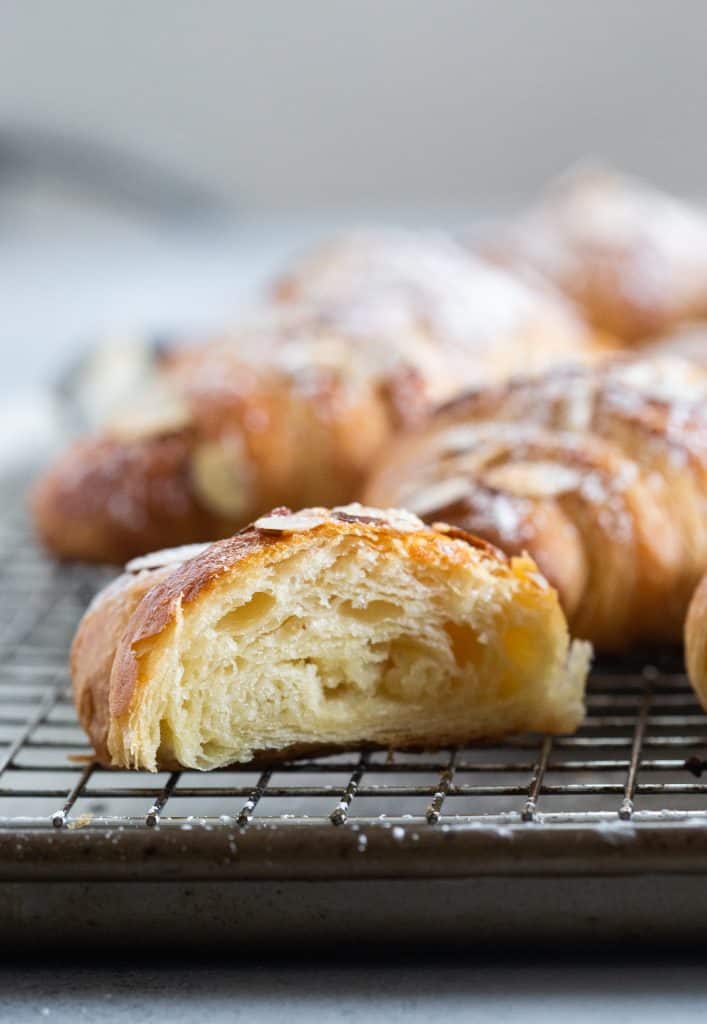
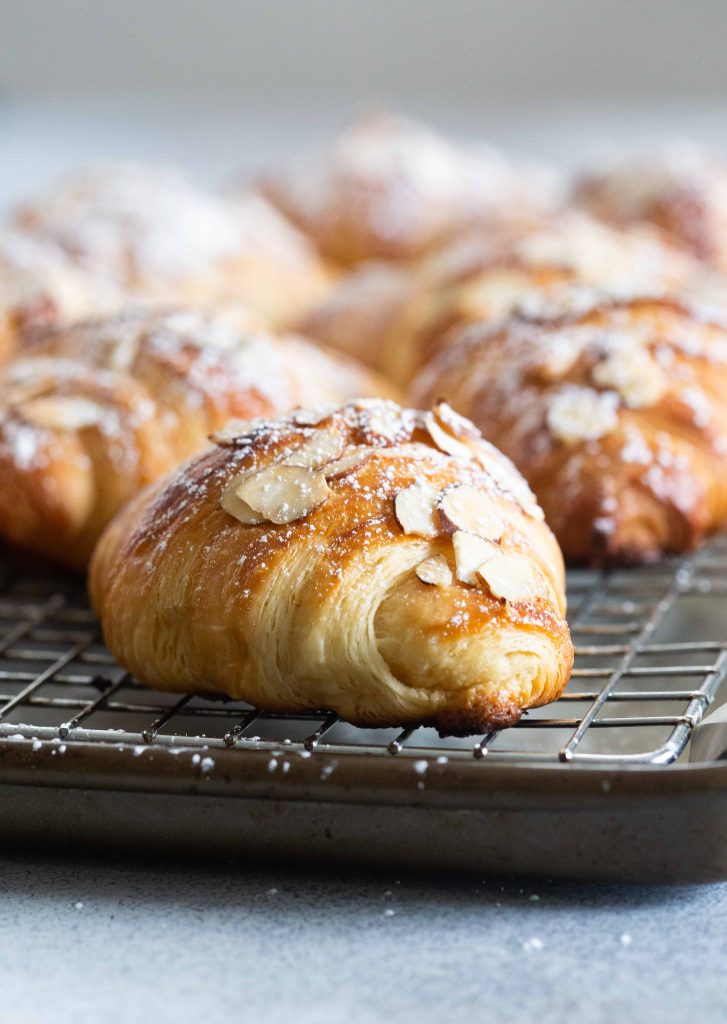
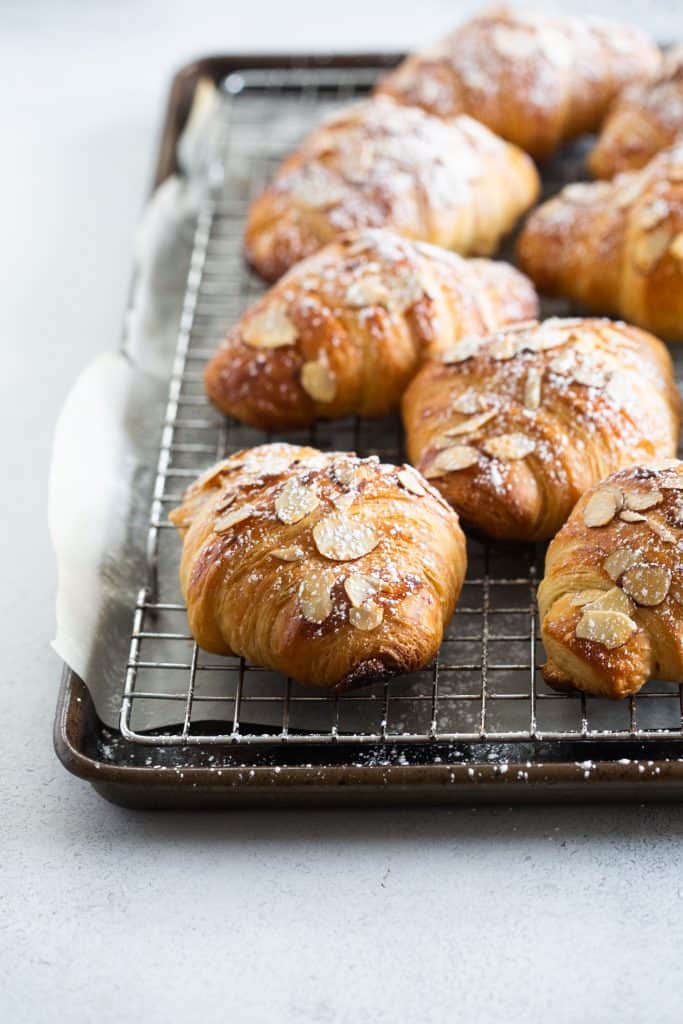
These are freaking fabulous!! I”m so impressed…I’ve been too stressed to bake even though I know it would make me feel better. Maybe this weekend.
Hey, could you help me out with the ingredients quantities? You have 100g / 1/2 cup flour in the poolish. Are you saying 100g + 1/2 cup? Because you then have 100g / 1/4cup water in the poolish. And I’m pretty sure 1/2 cup flour isn’t 100 g? Any additional information would be helpful. Thanks!
Hi! You can either use the gram measurements (100g) or volume (1/2 up plus 3T plus 1t)
Thank you!
Hello Baker Chick!! As croissants are such an investment – time and ingredient wise- is the dough mixing at 20min accurate? My mixer with stopped at 10 min and was over heating. My standing kitchenaid mixer is about 8 mo old. Thank you!
Hi Jim. I do mix my dough for 20 minutes, but you can definitely stop after 10 and see if the dough seems ready. You could finish kneading by hand as well.
Hello Laura- is 20 min mixing with dough hook accurate? My 8mo old kitchenaid stand mixer was having a hard time at 10m on low.
Thank you
Hi I like almond croissants that are sort of flat and very almondy – is that just a matter of putting extra almond frangipan in do you know.
Hi! I think extra filling and maybe extra almonds on top too!